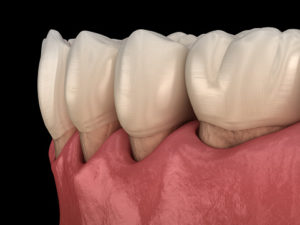
Gum recession can affect people of all ages. However, gum recession is much more common in adults. If it looks like your adult teeth are growing longer, this is a sign that your gums are receding. Gum recession is associated with gum disease which is a progressive infection of the soft tissue that supports the teeth. Gum recession can be localized to a small area of the gum or around several teeth. Often gum recession goes unnoticed because it usually does not cause pain. Visiting your dentist every six months can help prevent further recession of the gums that will eventually result in tooth loss. When you visit your dentist regularly, they can spot signs of inflammation and infection of gums and teeth.
Receding gums are a problem if left untreated. When your gums receive the proper care, it is possible to reverse any early damage and protect your gums from further damage. For treatment to be effective, gum recession must be detected early. Gum recession occurs overtime and you might not even notice you have gum disease. The gum slowly recedes away from your teeth causing tooth sensitivity and pain. These are some of the signs that gum recession is affecting your teeth. If your gums sometimes feel sore or your teeth feel sensitive, it could be because your teeth are more exposed due to weakness in the gums. This is a good time to consider visiting your dentist. Delay in gum recession treatment can lead to the irreversible gum recession, tooth decay, or complex dental procedures to restore gum health.
Some surprising facts about gum recession
It is true that gum recession is commonly associated with gingivitis and periodontal diseases. There are other causes of gum recession that might surprise you. When teeth are misaligned and crowded, the gums fitment between the teeth can shrink over time. Another factor is hormonal changes, pregnancy can cause muscle, soft tissue, and tendons to become loose. This can include the soft gum tissues around the teeth. This can cause the teeth to weaken. Bad habits such as clenching and grinding can exert unnecessary force on the gums and jawbone. There is strong clinical correlation between gum recession and bad habits such as cleaning and grinding. A less obvious factor is poor brushing technique, brushing with a hard-bristled toothbrush and brushing with too much pressure can wear the gums down. Excessive abrasion along the germline can cause the gums to bruise and cause infections.
What do with gum recession
If gum recession is cause by gum disease, some treatment options can range from deep cleaning and scaling, surgery, or gum grafting. Cleaning and scaling works by physically removing plaque and tartar buildup deep beneath the gum line. This removes the source of infection that is causing the gums to recede. More evasive treatments are surgery or gum grafting, this method removes healthy gums to patch the receded gums. This helps prevent the root of a tooth or teeth from developing further complications. A new and less invasive treatment is the use of lasers. Lasers can be gently clean and destroy the bacteria that is causing the gums to become inflamed. Laser treatment can cause less pain, reduce tissue loss without removing health gums, and slow or stop deep pocket development.
If gum recession is a problem for you, call California Dental Group to make your appointment at 800-407-0161. Our dental professional can help a treatment plan to help keep your gums healthy.

